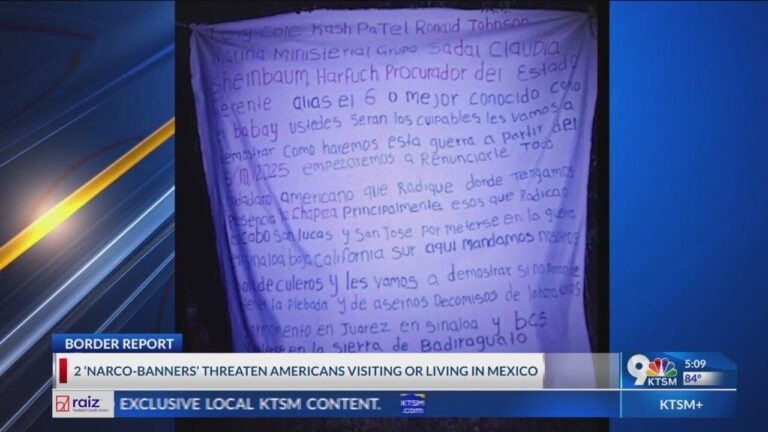Two banners allegedly posted by drug cartel members in Mexico have surfaced, warning Americans living in or visiting the country to stay away. The so-called ÔÇ£narco-bannersÔÇØ have once again drawn attention to the ongoing security challenges along the U.S.-Mexico border, raising concerns among travelers and residents. Authorities are investigating the authenticity and intent of the messages, while urging vigilance amid increasing cartel-related violence in the region.
Narco-Banners Signal Escalating Threats to Americans in Mexico
Recently, alarming narco-banners have surfaced across multiple regions in Mexico, explicitly targeting Americans who are either visiting or residing in the country. These messages, displayed in public spaces frequently, serve as stark warnings and threaten serious repercussions for any perceived interference with cartel activities. Authorities and local communities are on high alert as these banners not only spread fear but also indicate a potential escalation in cartel violence aimed at deterring U.S. involvement or scrutiny.
Key elements of the threats include:
- Direct warnings to tourists and expatriates about potential kidnappings or harm if they venture into restricted zones.
- Implicit threats against law enforcement collaboration with U.S. agencies, suggesting severe consequences.
- Public displays meant to assert cartel dominance and control over specific territories.
| Location | Message Type | Implication |
|---|---|---|
| Baja California | Kidnap Threat | Avoid interference with cartel operations |
| Jalisco | Collaboration Warning | Consequences for aiding authorities |
Analysis of Locations and Messages Targeting Tourists and Residents
The locations of the banners, reportedly placed in popular tourist areas as well as residential neighborhoods, appear to be strategically chosen to maximize visibility and impact. By targeting places frequented by both visitors and localsÔÇösuch as near border crossings, busy highways, and urban gathering pointsÔÇöthe messages seek to instill fear across diverse communities. These sites serve as critical crossroads where foreigners and citizens alike converge, heightening the banners’ potential to spread their warning efficiently. The proximity to the U.S.-Mexico border further emphasizes the intent to communicate directly with Americans traveling or living in Mexico.
The messages on the banners are explicitly threatening, combining ominous language with specific demands or warnings toward Americans. Below is a summary of key message elements found on similar narco-banners historically placed in the region:
- Direct threats against perceived offenders or foreigners involved in illegal activities.
- Warnings
- Claims of authority
- Calls for public attention
| Target Audience | Type of Location | Message Intent |
|---|---|---|
| Tourists | Roadside/highways near border | Warning to avoid specific behaviors or areas |
| Residents | Urban neighborhoods | Assertion of cartel dominance and control |
Security Measures Recommended for Americans Traveling or Residing in Mexico
Americans traveling or residing in Mexico should remain vigilant and take proactive steps to ensure their personal safety amid recent threats. It is advisable to avoid known high-risk areas where these ÔÇİnarco-bannersÔÇÖ have appeared. Maintaining a low profile, especially in border towns and regions notorious for cartel activity, can drastically reduce exposure to danger. Additionally, staying informed through official government travel advisories and local news updates is critical for timely awareness of emerging security concerns.
Practical measures include:
- Registering with the U.S. Embassy to receive alerts and assistance if needed.
- Traveling in groups and using trusted transportation services rather than public or unvetted options.
- Avoiding public displays of wealth such as expensive jewelry or electronics that might attract unwanted attention.
- Keeping emergency contacts handy, including local law enforcement and medical facilities.
| Recommended Security Tools | Purpose |
|---|---|
| Personal GPS Tracker | Quick location sharing in emergencies |
| Encrypted Messaging Apps | Secure communication |
| Portable Phone Charger | Ensure phone stays functional |
Mexican Authorities and US Agencies Respond to Growing Narco Intimidation
In response to recent displays of narco-banners targeting U.S. citizens, Mexican law enforcement agencies have stepped up patrols near tourist hotspots and border towns. These banners, strategically placed by cartel elements, carried explicit warnings aimed at Americans, discouraging travel or residence within certain regions. The authorities emphasize increased vigilance and collaboration with U.S. counterparts to mitigate threats and ensure the safety of visitors and expatriates. Key measures include:
- Heightened security checkpoints near border crossings
- Rapid intelligence sharing with U.S. law enforcement
- Community outreach to inform locals and tourists of safety protocols
The U.S. Department of State has also issued updated travel advisories, urging citizens to exercise caution and avoid areas showing signs of cartel activity. Joint task forces have been mobilized to monitor narco-related intimidation tactics, aiming to disrupt the networks responsible for these psychological operations. A recent briefing summarized current responses:
| Agency | Role | Recent Actions |
|---|---|---|
| Mexican Federal Police | Local Enforcement | Increased patrols near banner sites |
| U.S. Customs and Border Protection | Border Security | Enhanced screening procedures |
| Drug Enforcement Administration (DEA) | Intelligence | Operations against cartel logistics |
In Summary
As tensions along the U.S.-Mexico border continue to capture public attention, the appearance of these ÔÇİnarco-bannersÔÇÖ serves as a stark reminder of the security challenges faced by both travelers and residents in the region. Authorities on both sides are urging vigilance and caution, emphasizing the importance of staying informed through official channels. While efforts to combat cartel activity persist, visitors and locals alike are encouraged to remain aware of their surroundings and adhere to safety advisories to minimize risks in affected areas. BorderReport will continue to monitor developments and provide timely updates on this evolving situation.







